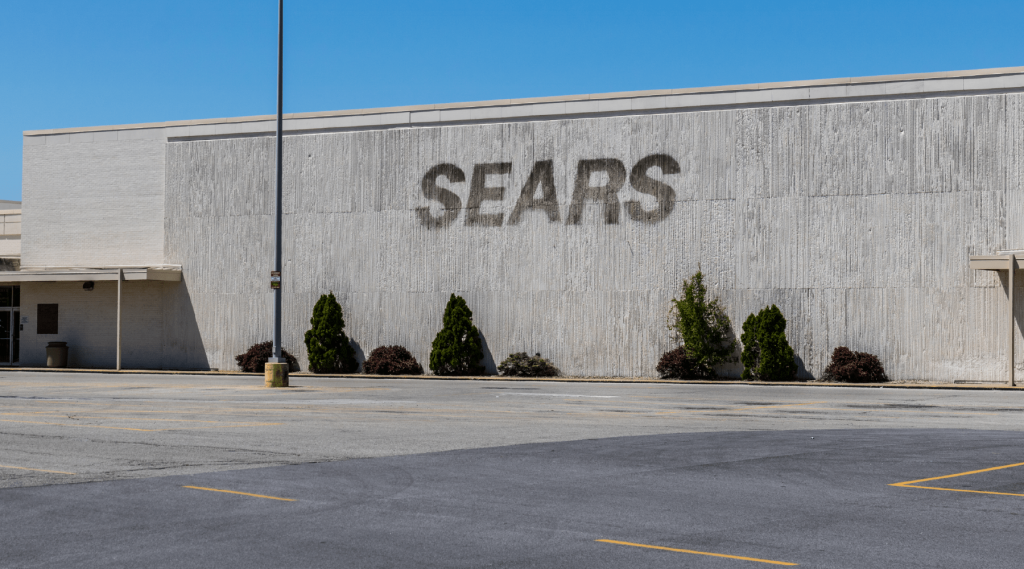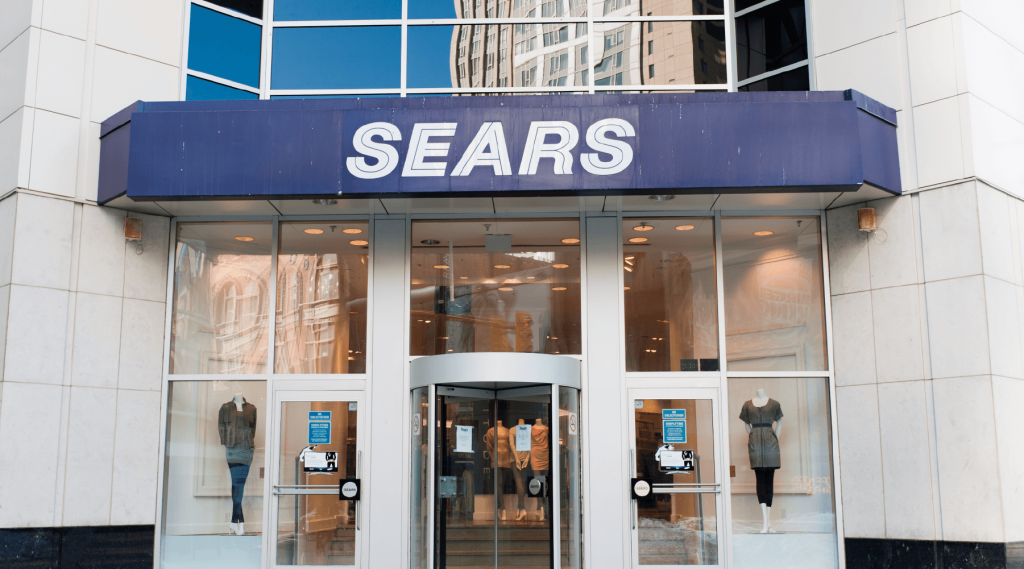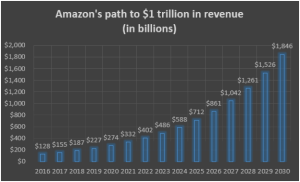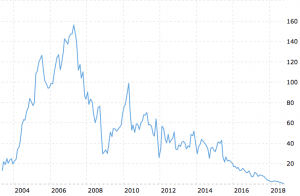From $11 Billion To Bankrupt – 6 Reasons Sears Lost it All
Table of contents
BONUS CONTENT INCLUDED THROUGHOUT THIS POST:
 ****<script src="https://js.hscta.net/cta/current.js" charset="utf-8"></script><script type="text/javascript">// <![CDATA[ hbspt.cta.load(3040938, '9a550f3d-0dad-4e36-a42a-b1fe660dea70', {}); // ]]></script><strong></strong>
****<script src="https://js.hscta.net/cta/current.js" charset="utf-8"></script><script type="text/javascript">// <![CDATA[ hbspt.cta.load(3040938, '9a550f3d-0dad-4e36-a42a-b1fe660dea70', {}); // ]]></script><strong></strong>
<div id="Introduction"><strong>Introduction</strong></div>
As long as you aren’t a member of Generation Z, then you most likely have memories of walking through Sears with your parents excited as you searched through rows and rows filled with products shown to grab your attention (as well as your parents’ wallets).
Whether you were shopping for Christmas, Back-to-school, or killing time as your mother tried on dresses, Sears was a staple in most people’s’ lives and the thought of the big-box retailer closing down seemed impossible.

Well, the impossible has come true. On October 15th, 2018, Sears has officially filed for bankruptcy and while you still may be able to find a location within your vicinity, they are planning on closing an additional 142 stores by the end of the year. When Sears first merged with Kmart back in 2005 when it purchased Sears for $11 billion, they had about 3,500 stores. Now, both chains currently only have about 894 locations in the United States left. This is alarming, especially for those who remembered Sears as the titan of its industry it once was.
While seeing such a large brand come tumbling down may instill some anxiety amongst business owners, there are many things you can do to assure your business doesn’t fall victim to a similar fate. One example is to use employee scheduling software to save on time spent scheduling, overtime, time theft, payroll, and more. Download this Workforce Management Calculator for free to see if your business could take advantage of employee scheduling software.
<center><span id="hs-cta-wrapper-d64a2b8a-1df6-49fa-90ca-c6b2a8b4132b" class="hs-cta-wrapper"><span id="hs-cta-d64a2b8a-1df6-49fa-90ca-c6b2a8b4132b" class="hs-cta-node hs-cta-d64a2b8a-1df6-49fa-90ca-c6b2a8b4132b"><a href="https://cta-redirect.hubspot.com/cta/redirect/3040938/d64a2b8a-1df6-49fa-90ca-c6b2a8b4132b" target="_blank"><img id="hs-cta-img-d64a2b8a-1df6-49fa-90ca-c6b2a8b4132b" class="hs-cta-img aligncenter" style="border-width: 0px;" src="https://no-cache.hubspot.com/cta/default/3040938/d64a2b8a-1df6-49fa-90ca-c6b2a8b4132b.png" alt="DOWNLOAD THE RETAIL ROI CALCULATOR"><br></a></span><script src="https://js.hscta.net/cta/current.js" charset="utf-8"></script><script type="text/javascript">// <![CDATA[ hbspt.cta.load(3040938, 'd64a2b8a-1df6-49fa-90ca-c6b2a8b4132b', {}); // ]]></script></span></center>
<div id="Sears1"><strong>Sears in its heyday (1880s-1990s)</strong></div>
To properly understand how Sears was able to be taken from its throne, you first must understand how Sears got the throne in the first place. Back in 1888, Sears first launched their famed Sears catalog during a time where most Americans were still making their own clothes as well as their own furniture. Sears helped introduce the idea of mass-produced items as well as products that helped reduce labor like washing machines, dryers, as well as a number of other items that saved people time when doing everyday household chores. Sears stores were also instrumental in the building of suburbs all across America as neighborhoods were sprung up around malls that contained their stores.

To add onto to all of that, Sears was also the nation’s largest employer during its heyday. Sears was on top of the world, until Walmart and Home Depot came along and started to give them a run for their money. Then the 21st century began and the internet came along and brought on a whole new host of challenges for the retailer. Continue reading as we go through and detail exactly what happened that caused the downfall of Sears.
<div id="The"><strong>The arrival of Walmart in the 90’s (1990s- early 2000s)</strong></div>
While Walmart is a household name in present times and most Americans couldn’t drive more than 20 minutes without passing one. In the early 90’s, Walmart was barely known. But it didn’t stay like that for long, the now iconic brand kept trudging along and before anyone knew it, Walmart emerged as a solid competitor to Sears.
Of course, this was a gradual process and didn’t happen overnight for Walmart. They had to figure out where the hole in the market was and think of methods of how they could fill it. The retail sector is a beast and any company looking to break in has their work cut out for them.
This quote by Barbara Kahn, a Wharton School Professor of Marketing, perfectly sums up how Walmart was able to become so dominant:
“Sears and Kmart did not differentiate themselves from the competition. Walmart came along with its great service and low-prices, other retailers started to innovate more with products and service. Sears and Kmart simply trudged along and thought that was good enough.”
Walmart had the prices, the locations, along with the customer service. They steadily began to climb the ranks while Sears decided to stay complacent instead of finding innovation to boost themselves and take advantage of the wide margin of dominance they had over every other retailer. This gave Walmart the opportunity to build their brand and to eventually overtake Sears as the size of their stores steadily grew in size as Sears, for the most part, stayed the same.
<iframe src="https://datawrapper.dwcdn.net/9UsmX/1/" width="710" height="227"></iframe>
Another aspect of Walmart’s success was their steady devotion and investment in technology focused on improving the experience for their customers, operations, as well as their employees. This can be seen in their recent release of a new mobile POS system for their lawn & garden centers that makes it easy to check out customers and print receipts out on the spot.
This POS system demonstrates Walmart’s commitment to customer service that convinced a size-able portion of the market share to ditch Sears and make the move to Walmart for their immediate retail needs. They saw that customers had issues paying for products when shopping in the lawn & garden center and would often have to spend time looking for an associate just to purchase items. They listened to their customers and came up with a modern solution to fix their issues.
Sears, on the other hand, has seemingly had the same interior since the early 2000s and hasn’t made any major changes to strengthen the functionality of their stores. As a result, their customers have been subjected to a retail experience that hasn’t kept up with the times, a mistake that Walmart has made sure not to make.
They also released Walmart pay, which makes it way more convenient for their customers to pay for their products. In regards to their employees, they released their very own app called My Walmart Schedule, which makes it easy for employees and managers to see their current schedules, claim unassigned shifts, as well as keep an eye on their vacation days and time off.
The use of technology to streamline operations is one of the reasons why Walmart has been able to stay so dominant, and other retail businesses should follow suit. While you may not have the resources to create your own scheduling app the same way Walmart has, you can use the same software used by Amazon stores, Nike, and Ace Hardware.  <script src="https://js.hscta.net/cta/current.js" charset="utf-8"></script><script type="text/javascript">// <![CDATA[ hbspt.cta.load(3040938, 'b23a97e9-75d8-46f5-a931-b4a72aad692d', {}); // ]]></script>
<script src="https://js.hscta.net/cta/current.js" charset="utf-8"></script><script type="text/javascript">// <![CDATA[ hbspt.cta.load(3040938, 'b23a97e9-75d8-46f5-a931-b4a72aad692d', {}); // ]]></script>
<center><span id="hs-cta-wrapper-457ce56e-63cb-40dc-b787-1e87a23302dd" class="hs-cta-wrapper"><span id="hs-cta-457ce56e-63cb-40dc-b787-1e87a23302dd" class="hs-cta-node hs-cta-457ce56e-63cb-40dc-b787-1e87a23302dd"><a href="https://cta-redirect.hubspot.com/cta/redirect/3040938/457ce56e-63cb-40dc-b787-1e87a23302dd" target="_blank"><img id="hs-cta-img-457ce56e-63cb-40dc-b787-1e87a23302dd" class="hs-cta-img" style="border-width: 0px;" src="https://no-cache.hubspot.com/cta/default/3040938/457ce56e-63cb-40dc-b787-1e87a23302dd.png" alt="NIKE USES THIS SOFTWARE, CLICK HERE TO TRY IT FOR FREE"></a></span><script src="https://js.hscta.net/cta/current.js" charset="utf-8"></script><script type="text/javascript">// <![CDATA[ hbspt.cta.load(3040938, '457ce56e-63cb-40dc-b787-1e87a23302dd', {}); // ]]></script></span></center>
While Walmart did a number of major blows to Sears, you can’t forget about the internet conglomerate that is Amazon.
<div id="Birth"><strong>Birth of Amazon (Mid 1990s-2010s)</strong></div>
Back in 1994, a young man by the name of Jeff Bezos quit his job as an investment banker for D.E. Shaw and settled into Bellevue, a Seattle suburb, with the unique idea of selling books using this new phenomenon referred to as the internet. He used a garage as the base for his business and originally incorporated it as “Cadabra” which is short for “Abracadabra”, but after some debating he finally decided to rename it to Amazon in reference to the world’s largest river. 20 years later, Amazon has annual sales of over $100 billion and Jeff Bezos has a net worth close to $150 billion.

Amazon is a perfect example of a retailing platform that took advantage of the internet and used it to its strengths rather than letting itself be left behind. Many retail business owners make the mistake of ignoring the internet and relying on their brick & mortar store as a sole revenue of profits when they could start a site, sell their products online, and be opened up to a whole other avenue for profits.
While people may assume that the internet killed everyone and that every other major big-box retailer may suffer from the same issues as Sears, the reality is that Lowe’s, Best Buy, and Home Depot have all seen their stock share prices double while Amazon has increased by nearly 33-fold. Sears, on the other hand, has seen 96% of their value disappear since trading under their current ticker name (SHLDQ) in 2003.

<div id="Sears2"><strong>Sears and the Internet Revolution (Mid 1980s- Present day)</strong></div>
You’re probably expecting this section to begin with a long detailed story on how Sears never embraced the internet and why that was eventually what caused their downfall. In reality, the irony is that Sears was ahead of the curve in regards to online shopping. I know that it may be odd to hear the words, “Sears”, “Online Shopping”, and “ahead of the curve” in the same sentence, but let me explain.
Back in the very early days of the internet (80’s to early 2000s), Sears merged with Prodigy (an online service that gave its subscribers access to a wide range of networked services like games, weather, shopping, stocks, etc.) This showed that Sears was taking the internet seriously and were selling a wide range of hardware and appliances online at a time where Amazon was only selling books. In fact, back in 2002, the online component of Sears was dubbed the “New Sears” catalog and Sears was praised for its swift entrance into the online market. The problem wasn’t that Sears missed the internet, it’s that they were still anchored to their retail past and refused to move on.

This is especially evident when analyzing their sale of Prodigy in 1996. Despite the strides Sears made in the internet realm, they seemed to halt the progress they made and refocus their attention on retail. The problem was that Walmart was no longer playing the “little brother” role and had grown to dominate the retail industry in the early 2000s. So much so that consumers were losing interest in Sears and were instead turning to Walmart to fulfill their retail needs. This was hurting Sears retail revenues, so they refocused on retail.
Another problem was that, due to Sears constantly shifting their focus, they weren’t taking the internet as seriously as they should. A brand that was taking the internet seriously was Amazon and it was all too late for Sears to take control of the internet as they hoped they would. Amazon provides better prices, better customer service, better delivery options, as well as a more established brand online. In other words, Amazon gave people no reason as to why they should choose any other brand for their online shopping needs, especially Sears. To make sure you aren’t stuck in a similar situation as Sears, make sure you’re keeping up with all of the latest innovations in your industry and are staying up-to-date with what your competitors are doing.
A good example can be seen in the back & forth between Apple & Android. When Apple made fingerprint scanners part of their iPhones, Android went and added the same technology to the Galaxy. This tug-of-war continues and if either were to come out with a new type of technology, then you can be assured that the other will be soon to implement the same tech within their own hardware. Your business needs to display the same competitive spirit in terms of your retail operations. If you run a pizzeria and the pizza place across the street starts to offer catering options, then you should try to come up with your own competitive offer. If you’re running a bar and your main competitor offers many happy hour specials that attract a large crowd, you should do your best to also offer happy hour specials so you can cut into some of their customer base.

Every retailer needs to take an inward look at their business practices to assure they aren’t missing out on the next big wave. One way to do this is by analyzing your competitors to see if they’re being profitable on an idea you haven’t moved on yet. You should also pay close attention to what’s going on within your industry so you don’t get left behind.
Sears failed to change with the times, make sure you don’t let the same happen to your business. One way to assure your retail business doesn’t fall victim to a competitor taking you out, is by staying on top of the value of your store’s inventory so you know you aren’t losing money on sales or running out of products.
<center><span id="hs-cta-wrapper-1103ef57-252e-41dc-96ec-e9d56e266c45" class="hs-cta-wrapper"><span id="hs-cta-1103ef57-252e-41dc-96ec-e9d56e266c45" class="hs-cta-node hs-cta-1103ef57-252e-41dc-96ec-e9d56e266c45"><a href="https://cta-redirect.hubspot.com/cta/redirect/3040938/1103ef57-252e-41dc-96ec-e9d56e266c45" target="_blank"><img id="hs-cta-img-1103ef57-252e-41dc-96ec-e9d56e266c45" class="hs-cta-img aligncenter" style="border-width: 0px;" src="https://no-cache.hubspot.com/cta/default/3040938/1103ef57-252e-41dc-96ec-e9d56e266c45.png" alt="DOWNLOAD THE RETAIL INVENTORY METHOD CALCULATOR"></a></span><script src="https://js.hscta.net/cta/current.js" charset="utf-8"></script><script type="text/javascript">// <![CDATA[ hbspt.cta.load(3040938, '1103ef57-252e-41dc-96ec-e9d56e266c45', {}); // ]]></script></span></center>
<div id="Sears3"><p style="text-align: left;"><strong>Sears lack of positioning (Late 1990s-Present day)</strong></p><p>The real problem for Sears isn’t that the internet stabbed them in the heart, it’s because they failed to position themselves and build out a profitable niche. Think of it like this, when you’re in need of groceries or other basic supplies like toothpaste, cat food, or socks, you’ll be quick to head down to Walmart. On the other hand, if you’re in need of some new clothes that will help you make an impression at your social events, you ‘ll take a trip to Nordstrom to pick up a new outfit or two. Or maybe you just moved to a new apartment and are in need of a new 40-inch tv but don’t feel like leaving your bed, so you log into your Amazon account and search through dozens of TVs until you find the one that’s a perfect fit for you.</p><p>What I’m getting at here is that brands like Walmart, Nordstrom, and Amazon have been able to position themselves in a niche that’s profitable enough to support a business. This is where Sears went wrong, through their historical dominance of so many areas of life, whether it be housing, clothes, hardware, furniture, etc. they fought to keep this idea alive in a time where it is almost impossible. With the rise of the internet, there’s almost an infinite amount of competitors out there that are all vying for a piece of the market and make it extremely difficult for any single brand to dominate at the level that Sears once did.</p><hr><p><strong>“But….but, what about Amazon?!”</strong></p><p>While Amazon is growing to be a dominant force and is giving Walmart a run for their money, most people aren’t flooding to Amazon when they’re shopping for new clothes, most people aren’t flooding to Amazon to buy their weekly groceries <a href="https://www.theatlantic.com/business/archive/2017/06/why-amazon-bought-whole-foods/530652/">(although Amazon is making strides in this space but that’s for another blog)</a>, even a conglomerate like Amazon has their limitations and this is what Sears failed to realize. With the historical success of their Sears catalog, they fought to retain the title of a single dominant brand that controls every aspect of their customers’ lives, a title that will be hard to come by for any single brand in our current day & age. If Sears was willing to focus in on their hardware offerings, furniture, and other lifestyle products, they may very well not be in the situation that they currently find themselves.</p><p>What your company needs to take from this segment is the importance of finding your niche and sticking to it. No matter what it is that you sell, you need to conduct plenty of market research and have a thorough understanding of your buyer persona to assure you understand what motivates your target demographic to buy.</p><hr><div id="Malls"><p><strong>The decline of malls (Mid 2000s-Present day)</strong></p><p><img class="aligncenter size-large wp-image-38745" src="https://www.deputy.com/uploads/2018/11/What-Happened-to-Sears_-A-Step-By-Step-Breakdown-for-Retail-Business-Owners_Content-image3-1024x569.png" alt="What Happened to Sears? A Step-By-Step Breakdown for Retail Business Owners" srcset="https://d21pqaamub0upm.cloudfront.net/dptycms/wp-content/uploads/2018/11/What-Happened-to-Sears_-A-Step-By-Step-Breakdown-for-Retail-Business-Owners_Content-image3-1024x569.png 1024w, https://d21pqaamub0upm.cloudfront.net/dptycms/wp-content/uploads/2018/11/What-Happened-to-Sears_-A-Step-By-Step-Breakdown-for-Retail-Business-Owners_Content-image3-300x167.png 300w, https://d21pqaamub0upm.cloudfront.net/dptycms/wp-content/uploads/2018/11/What-Happened-to-Sears_-A-Step-By-Step-Breakdown-for-Retail-Business-Owners_Content-image3-768x426.png 768w" sizes="(max-width: 1024px) 100vw, 1024px"></p><p>With the other areas concerning the failure of Sears covered, it’s time to touch on malls. While malls used to be a staple of American living, they have been on the <a href="https://money.cnn.com/2017/12/12/news/companies/mall-closing/index.html">decline for some years now</a>, in fact, it’s expected that 1 out of every 4 malls in the US will be closed down by the year 2022. This is especially bad news for department stores like Sears where the majority of locations are found inside malls. The reason why so many malls are failing to remain popular is mainly due to the growing popularity of online shopping. Online, consumers are able to purchase anything from a sofa to a new designer jacket all from the comfort of their homes.</p><p>That said, not all malls are on the brink of failure. There are plenty of malls that are not only avoiding failure but are <a href="https://www.cnbc.com/2017/01/26/why-these-malls-are-thriving-while-others-die.html">growing in profits</a> to the point where they are investing in expansion just to make space for new stores that want to set up shop in their location. The difference is that the malls that stay open are in marketable locations and cater to high-end clientele. Sears, on the other hand, does not appeal to a high-end clientele and the malls they were located in got left behind. A lesson that retail businesses can take from this is to pay very close attention to the <a href="ftp://ftp.repec.org/opt/ReDIF/RePEc/rdc/v1i2/8.pdf">location they’re opening their business in</a>. And if they decide to open up in a mall, then they should choose a mall that contains a number of high-end brands and isn’t showing any signs of slowing down (signs include numerous abandoned stores, low amount of customers walking around, etc.)</p><hr><p><strong>Final thoughts</strong></p><p>Sears was once a titan of its industry. They were responsible for building, at the time, the <a href="https://www.investopedia.com/news/downfall-of-sears/">largest building in the world</a> and the brand was a staple in every Americans’ life. That said, the fall of Sears has proved once again that there is no company that is too big to fail. To ensure that you’ve taken in all of the important points stated in this piece, pay close attention as we do a quick recap on why Sears was unsuccessful.</p><p><strong>1.</strong> Sears shifted their focus too often. This caused them to fall behind and give Walmart enough leverage to dominate the retail space.</p><p><strong>2.</strong> While Sears showed promise in regards to their commitment to the internet, that commitment proved to be short-sighted. This led to brands like Amazon dominating the platform.</p><p><strong>3.</strong> Location, location, location. As the majority of malls started to drop in popularity, Sears got caught in the crossfire as the majority of their locations were found in malls that weren’t high-end. So as they closed down, so did Sears.</p><p>As you can see, keeping a business profitable & relevant for a prolonged period of time can be difficult. Through the fall of Sears and the rise of Amazon and Walmart, you can see firsthand how these brands evolved in order to stay competitive and provide the best experiences for their customers. One of the best ways to make sure your retail operation runs well is to hire and retain great employees. Asking the right questions can make all the difference in the world in an interview. <a href="https://www.deputy.com/au/blog/77-retail-interview-questions-to-hire-the-right-candidate">Click here</a> to download a one-page document with 77 retail interview questions. Retaining employees is hard, but a proven strategy is to use technology to help schedule them, communicate with them, and manage performance. You can try <a href="https://www.g2crowd.com/categories/workforce-management#highest_rated">G2 crowds top-rated suggestion</a> for those tasks below:</p><p></p><center><span id="hs-cta-wrapper-bb5b5a9c-0623-4768-b1d3-30732fb7dbc3" class="hs-cta-wrapper"><span id="hs-cta-bb5b5a9c-0623-4768-b1d3-30732fb7dbc3" class="hs-cta-node hs-cta-bb5b5a9c-0623-4768-b1d3-30732fb7dbc3"><a href="https://cta-redirect.hubspot.com/cta/redirect/3040938/bb5b5a9c-0623-4768-b1d3-30732fb7dbc3" target="_blank"><img id="hs-cta-img-bb5b5a9c-0623-4768-b1d3-30732fb7dbc3" class="hs-cta-img" style="border-width: 0px;" src="https://no-cache.hubspot.com/cta/default/3040938/bb5b5a9c-0623-4768-b1d3-30732fb7dbc3.png" alt="Try G2 Crowd's #1 Workforce Management App"></a></span><script src="https://js.hscta.net/cta/current.js" charset="utf-8"></script><script type="text/javascript">// <![CDATA[ hbspt.cta.load(3040938, 'bb5b5a9c-0623-4768-b1d3-30732fb7dbc3', {}); // ]]></script></span></center></div></div>
